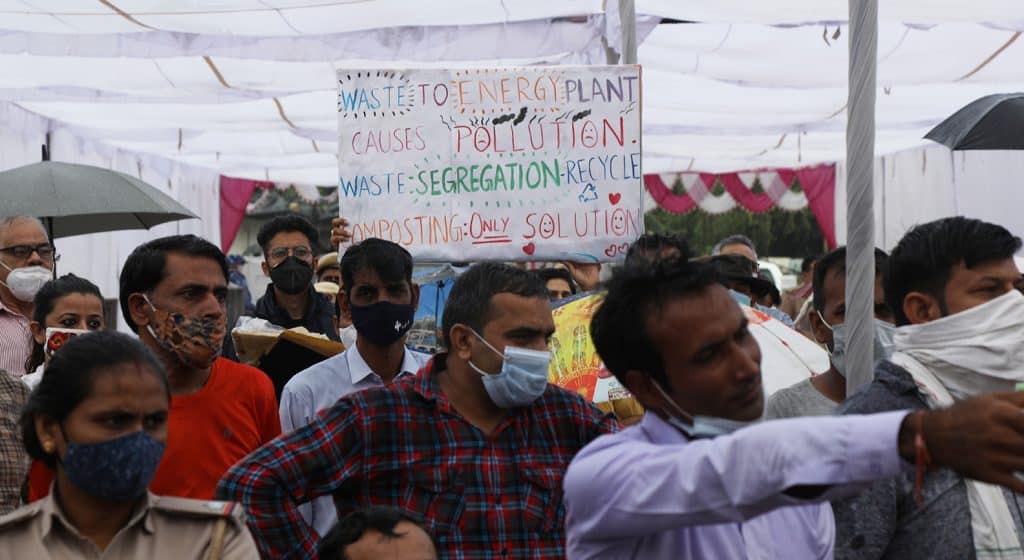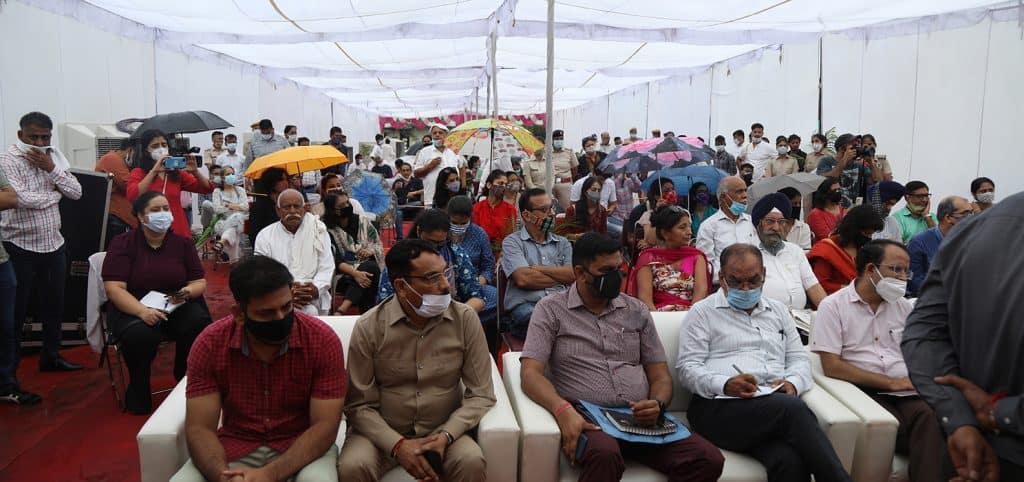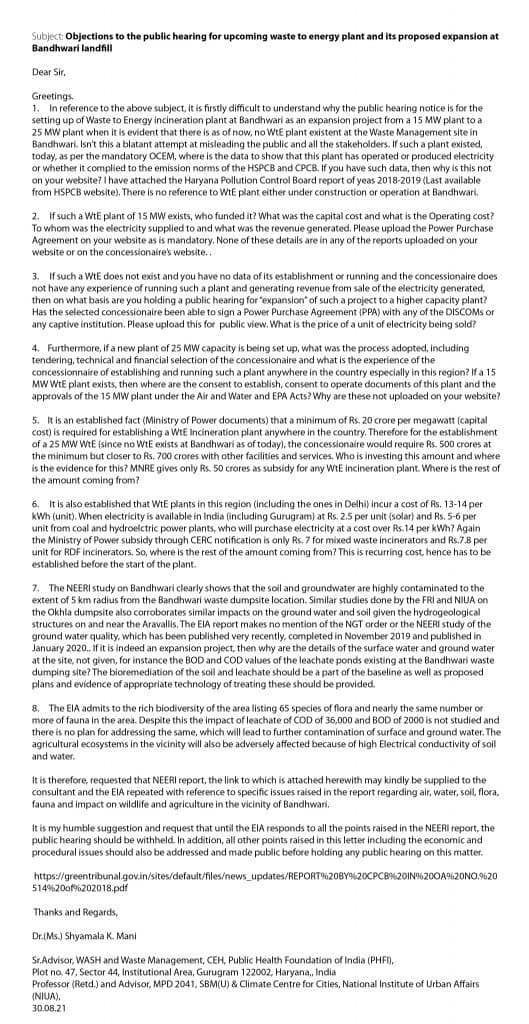It is not every day that the citizens of Gurgaon leave work on a Tuesday morning to congregate at the approximately 45 m-high Bandhwari landfill, shared by Gurgaon and Faridabad, where over 2000 tons of mixed waste is dumped every day. On the morning of August 31st, however, rain could not deter close to 200 residents of villages from Mangar, Bandhwari, Gwal Pahari and the city of Gurgaon, who gathered there to attend a public hearing called by the Haryana Pollution Control Board (HSPCB). The hearing sought citizen’s thoughts on the proposed expansion of the Waste to Energy Plant (WtE) in Bandhwari village from 15 MW to 25 MW.
Surprisingly, news of the hearing had been announced only in the English dailies distributed in Gurgaon and in the Hindi newspapers of Himachal Pradesh which meant that the villagers in the immediate vicinity of the landfill learnt about it only a few days before the date of hearing. Moreover, the Environmental Impact Assessment (EIA) Report was made available only three days in advance for public viewing instead of the stipulated 30 days by Indian law.
Close to 60 policemen stood guard at the base of the waste mountain, in the tent and around the officials seated on a stage. It poured relentlessly, leachate from the landfill seeped through the red carpets and yet, the attendees waited patiently to voice their anguish. Thousands of citizens and over 25 Resident Welfare Associations had already sent out letters protesting against the upcoming WtE plant and its proposed expansion.
The concessionaire, Ecogreen, managing the city’s waste since 2017, had already been granted clearance to build a WtE plant in Bandhwari in a public hearing in 2018. The plant was set to be commissioned by 31st May 2019 but there are no signs of it as of now. Residents have been frustrated by Ecogreen’s inability to manage city wide collection, resource recovery or proper disposal of the collected waste. Mixed waste is collected in vehicles which have no space for segregated waste in most parts of the city. In spite of indefinite promises, there have been negligible efforts towards creating a model ward.
Read more: Why NCR citizens are against a waste to energy plant at Bandhwari
Paid by the ton in tipper fee, the collectors have been incentivised to pick up mixed waste laden with construction and demolition waste and dump it at the landfill. The machines segregating waste on site break down frequently due to the huge amount of rubble and construction waste loaded on them. There is little faith in Ecogreen’s ability to handle collection, transportation and composting, let alone operate a large and complex WtE.
Citizen voices
Objections on various fronts poured in from citizens at the hearing. Anuradha PD from the Aravalli Bachao citizens’ group demanded a cancellation of the proceedings on the basis of the fact that the EIA report was not made public thirty days in advance.
Sunil Harsana from Mangar village also asked, “How can they do a public hearing after putting ads in the English newspapers and then come sit here? Why don’t they do a public hearing in our villages where our mothers and sisters can attend and share their grievances: the sickness and struggles they face every day with drinking water as all the wells have been contaminated by the leachate from the landfill.”
Sunil spoke of how these villages, thousands of years old, had never experienced contaminated soil, water and air till urbanisation kicked in. “They show us fancy projects but end up destroying our sacred forests by dumping their waste in them. The animals are dying… we are suffering from diseases such as cancer and it is expensive for us to get proper treatment.”

Abhay Punia, a resident of SunCity, Sector 56 questioned the basis of the proposed expansion, since the construction of the plant has not even started.
Dr Sarika Verma, an ENT Surgeon, said that every fourth child in the city has asthma and needs to be nebulised. In spite of the 2016 Solid Waste Management (SWM) Rules and segregated waste given by communities, the waste is mixed up by Ecogreen on collection. She talked about the negative health impacts of the WtE plant under such circumstances, and how it would worsen the already abysmal air quality. She was joined by Dr Sanjay Sharma in her arguments against the plant expansion. “A fire in the Bandhwari landfill a few weeks ago had choked people even 10 kms away, imagine how unlivable the WtE plant would make the environment!” they said.
Mahesh Dayma, Municipal Councillor, Ward 30, said that the house had voted for the removal of Ecogreen on the basis of its incompetence over the years but MCG has not acted upon their resolution.
All the ex Sarpanches of Bandhwari as well as Gwal Pahari too spoke against the landfill, condemned the upcoming plant and emphasised how their lives had already been ruined. “Why don’t we just die here now, rather than have this toxic plant kill us slowly?” they asked, the anger in their voice rising and their anguish getting more palpable with each passing objection.
Vaishali Rana, a resident of Gwal Pahari, questioned the Environmental Clearance (EC) received from the central govt (MoEFCC) to build a WtE Plant in the Aravallis. The EC itself was based on false information furnished by MCG/Ecogreen (as per RTI replies received). In their application, Ecogreen had not disclosed that the Aravallis enjoy protection from the Supreme Court of India and a blanket ban on any kind of non-forest activity in forest areas. She noted that no health camps had been organised for the villagers in spite of many promises after the 2018 public hearing. Water in five adjoining villages was now contaminated, as per CPCB and NEERI reports, as compared to three earlier. There has also been no response on what action/penalties would be imposed in case the emissions from the plant (both poisonous gases and toxic ash) violated permissible limits. No land had been earmarked for safe disposal of fly ash by the EIA.
Shashi Bhushan representing waste workers talked about prioritising source segregation so that their livelihoods would not be affected. SWM Rules 2016, strictly enforced, would leave no need for a toxic landfill or WtE plant.
Read more: How RWAs in Gurugram are showing the way out of urban India’s waste crisis
Neelam Ahluwalia from Wellington Estate, Sector 53, wanted the authorities to call for a round table of active citizens of Gurgaon and Faridabad and solid waste management experts from around the country to discuss sustainable models for Gurgaon and Faridabad to make Gurgaon a sustainable model city.
Ruchika Sethi Takkar from Citizens for Clean Air insisted that the focus be on decentralised waste management and resource recovery rather than the building of a polluting plant.
A representative of Earth Saviours Foundation, an old age home converted to a shelter for most of the city’s abandoned and unwell senior citizens, pleaded that the plan be scrapped as they have 800 mentally and physically challenged people housed in their Bandhwari premises. The detrimental effect to the air, soil and water would only cause further harm to their health.
Rahul Khera, a composting expert, pointed out that Ecogreen, already slammed with so many fines because of their inefficiency and incompetence, could not be trusted to run a WtE plant that requires an extremely high level of expertise, diligence and environmental compliance.
I urged the authorities to respond to all questions raised in the public hearing officially on the HSPCB website in writing, as thousands of people and RWAs who had sent in their objections through letters, too, would like to know the responses to all objections raised. Ecogreen inherited a completely bio-remediated landfill in 2017, but thereafter kept adding to the mountain of untreated fresh waste, increasing it’s height from 7 m to over 45 m in the last four years! What were their plans to manage this accumulated legacy waste? It would be misleading to believe that the WtE plant would solve this problem as only a small portion of this waste could be potential fuel for the proposed plant.
Problems with waste to energy: What experts say
National experts like Almitra Patel (Member, Supreme Court Committee for Solid Waste Management & National Expert, Swachh Bharat Mission, Govt of India (GoI)) and Dr Shyamala Mani (Professor (Retd.) and Advisor Swachh Bharat Mission & Climate Centre for Cities, National Institute of Urban Affairs (NIUA)) shared concerns along with the residents on the proposed idea of a WtE plant.
Almitra Patel said that the large amount of non-combustible debris in the waste, brought in to earn higher tipping fees or transport by weight, will destroy the working of any WtE plant. The Municipal Corporation Gurugram (MCG) should first cap payments by weight to 0.55, or max 0.6, tons per cubic metre of vehicle volume, regardless of overweight shown at Bandhwari. That is the bulk density of segregated wet waste or even debris-free mixed waste.
“More importantly”, she added, “on 15.5.2007, the Hon Supreme Court conditionally permitted Ministry of Non-conventional Energy Sources (MNES) with five WtE pilot projects chosen by them, keeping in view the recommendations made by the Expert Committee (on WtE) and then take appropriate decision in the matter. In fact, none of the five pilot projects selected by MNES for this conditional permission ever saw the light of day. Yet GoI persists in subsidising the clearly unviable and hazardous burn options for WtE in defiance of these orders.”
Read more: Why burn garbage when there are better alternatives
Dr Shyamala Mani, in her objection letter, stated: “The NEERI study on Bandhwari clearly shows that the soil and groundwater are highly contaminated to the extent of 5 km radius from the Bandhwari waste dumpsite location. Similar studies done by the FRI and NIUA on the Okhla dumpsite also corroborates similar impact on the ground water and soil given the hydrogeological structures on and near the Aravallis. The EIA report makes no mention of the NGT order or the NEERI study of the ground water quality, which has been published very recently….If it is indeed an expansion project, then why are the details of the surface water and ground water at the site, not given, for instance the BOD and COD values of the leachate ponds existing at the Bandhwari waste dumping site? The bioremediation of the soil and leachate should be a part of the baseline as well as proposed plans and evidence of appropriate technology of treating these should be provided.”
All voices present at the public hearing vehemently opposed the proposed plant in the Aravalli forest. Citizens who wrote in and experts quoted above also have their reservations. With increasing air pollution and the city gasping for breath most days of the year, it is indeed unfortunate that our government, city planners and administrators are not investing public money, attention or energy towards more decentralised and sustainable solutions. Sacrificing forest area, clean air and a precious yet dwindling ecosystem to burn waste will exacerbate the environmental nightmare already playing out at Bandhwari. In a world where climate change is the harsh reality, showing up in extreme ways, this would only jeopardise the local villages, the city of Gurgaon and the National Capital Region further.



I want to give very brief comment as I have seen the developments pertaining to Ecogreen and the el site.
First of all Ecogreen has no capability for managing solid waste which can be see by the mess created at Badhwari site which will cost heavily for the government to rectify. Despite my repeated requests to the MCG they did not disqualify Ecogreen from dealing with wastes in Gurgaon infact they were pressurised the citizens to give their waste to Ecogreen. The main problem was mixing of all wastes and increasing the bulk for monitory benefit as well raising this crisis situation so that they can suggest W2E as the solution. Now it’s time to look for an alternative agency before it is too late even though it is already too late.
This in addition to the comments provided by Almitra Patel and Shyamala Mani. We had long association since1997 and I had dealt with the PIL in Honourable Supreme Court. Some of the mentions are outdated as there has been lot of studies on Bhandhwari site which needs to be collated and discussed before they can be allowed to continue.